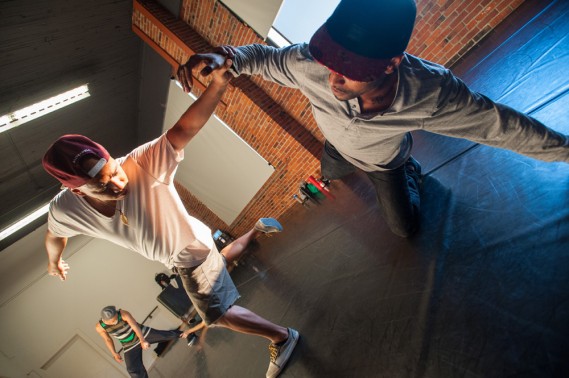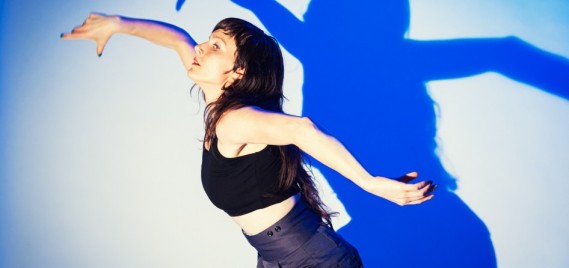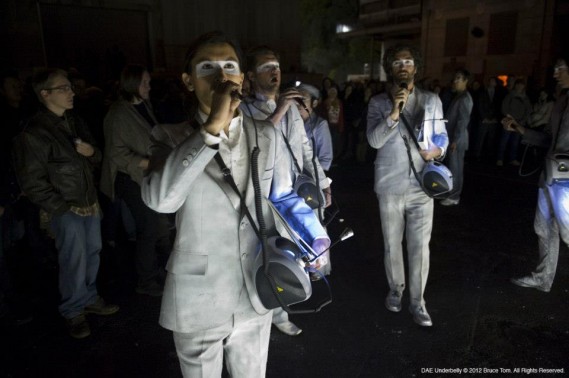Artist to Artist: Amy O'Neal and Degenerate Art Ensemble Discuss Collaborative Practices in Dance, Choreography and Site-Specific Performance
As part of our “Artist to Artist” interview series, Seattle-based artists Joshua Kohl and Haruko Nishimura of Degenerate Art Ensemble (2013 Performing Arts) spoke with choreographer Amy O’Neal (2006 Performing Arts), also based in Seattle, about collaboration in dance, choreography and site-specific performance work. The following is an edited excerpt from their conversation. You can listen online to the full podcast, or subscribe through iTunes.
Joshua Kohl: We thought we could talk about a whole bunch of things because we have a lot in common, and a lot of differences in our work.
Amy O’Neal: And we’ve known each other in the Seattle community for at least ten years, or more?
Joshua: Probably more.
Amy: And have been each other’s work in various ways.
Haruko Nishimura: Yeah. And we do both music and dance and different media. Maybe we could talk about process or collaboration? Amy, I know you have five projects right now, but, generally, how do you start the process from you, and how do you spread or hand over or share to another collaborator in your team or in your project?
Amy: So, this next project I’m doing is called Opposing Forces and I’m working with a cast of B-boy break dancers from Seattle. And I’m working with DJ WD40 to make original music. It’s going to premiere at On the Boards in October.
Joshua: Nice.
Amy: In writing about the project and trying to get funding and talking about it, I’m starting from one central question, which is talking about perceptions of femininity and how that affects male behavior. So I start with a concept or question or area or place of mystery that I kind of want to dig into, and then… We just started rehearsals, so I’ve had some physical practices of my own that I’ve been doing in classes and in rehearsal, and I’ve just been throwing those things at the B-boys and getting them to improvise and move their bodies in a way they haven’t really thought about doing.
Haruko: Wait, so you talked about femininity… Is it a physicality of dance moves?
Amy: That’s where we’re starting, yeah.
Joshua: You mean like asking, “What is feminine movement?”
Amy: Kind of. Like last night we played around with just sort of movement in terms of opposite qualities, instead of, “What do you think is masculine and what do you think is feminine?” We just sort of threw out a bunch of different words—hard and soft, light and dark, you know, just opposites—and they improvised from that place of getting into one quality and sticking with it and then letting it morph into the opposite quality. It gets into the ideas of masculinity and femininity but without going so directly at it, if that makes sense.

Amy O’Neal, Opposing Forces: Rehearsal at Velocity Dance Center. Photo by Bruce Clayton Tom. Opposing Forces premieres at On the Boards October 23-26, 2014.
Haruko: Can you tell us a little bit more about the B-boy community? Is it men and women mixed? What are the age groups? How are they taking it when you throw this femininity quality…?
Amy: B-boys are all men, and then a B-girl would be a girl. I wanted to work with guys only, because, I think, hip-hop culture, B-boy culture—I mean, it is a very masculine form. I just participated in my first battle and there were 50 plus dancers and there were five girls battling and 50 guys.
Haruko: Wow!
Amy: It’s normal that women tend to be underrepresented. And it’s also perceived to be the most masculine dance form. If a guy says he’s a dancer, sometimes people will question his sexuality, but if he says he’s a B-boy or break dancer, he’s a hero, he’s got it going on. So, I wanted to work with the most, quote unquote, perceived-masculine dancers. The guys I’m working with are a range of ages. The oldest guy is 44, the youngest guys are 21, and there’s two guys in the middle—one is early thirties and one is my age—and some of them I’ve known for a long time, and others I’ve met over the past few years. One of them was a student of mine. So, there’s already a connection and a mutual respect amongst one another. The oldest guy, Fever One, he’s from the Rock Steady Crew in New York, which is one of the oldest crews.
Haruko: Historical! Amazing.
Amy: He has so many amazing stories and he’s danced and battled with all of the legends, and he’s kind of been a main teacher for every B-boy in Seattle, pretty much. He’s been like a mentor to everybody. And he’s kind of the most, like, tough…but he’s so open. Yesterday he really surprised me in the way in which he was moving and exploring. I had them each leading a flocking exercise, where you have to be in unison together—you move your position in space and whoever’s in front leads and—
Joshua: Kind of like those Viewpoints exercises.
Amy: Yeah, totally. So they all are sort of trying on each other’s perceptions of what the idea is. And they were all just so playful and open and totally into it. And then we started talking about, at the end of rehearsal, ways in which they felt objectified. In addition to making the piece, we’re also making a documentary, so I have a cinematographer in the studio who’s filming all of it.
Haruko: So we get to see this. Amazing!
Amy: Yeah. Which is new because traditionally in my work, for so long, there’s been this marriage of video and dance and performance and this is the first time I’m really separating them.
Joshua: You mean, a film about it, and then the dance.
Amy: And no video involved in the performance, at all. So, that’s really new for me, which is kind of old school.
VIDEO: Amy O’Neal Choreography Reel
Joshua: When you started out, you were like heavy modern, right?
Amy: Yeah.
Joshua: And you’ve come to hip-hop. So how did that happen?
Amy: Well, I think in the work I was doing with locust, there was always a hip-hop flavor in the music that Zeke [Keeble] was writing because that’s all he listens to—and did listen to, at the time we met. And hip-hop, for me, was always a very social dance, and it’s something that I always did, but hanging out with people. When I was growing up, there were no hip-hop classes you could take, you’d just watch MTV and learn off of the TV. So, I was always doing that and there was always sort of a flavor, a hint of it in what was going on. But I think that the older I’ve gotten, and the more access I have to learning about it, I’ve gotten more into it. And also, the more I get questioned as a white woman who teaches hip-hop dance—I’ve just realized, over the past eight to ten years, I have to do my homework. I really need to know my shit. If I’m going to claim that as part of my artistic expression, I need to know my shit, for real.
Joshua: It’s like this funny combination: You have to know your shit and you have to do what you love. Even if you do know your shit, people are still going to question you.
Amy: Totally.
Joshua: But, if you give respect to the history and to the origins and to the technique and all those things, then at least for yourself you feel like, I can do what I like and—
Haruko: I have the language.
Joshua: I think it’s a really interesting thing. We’ve been getting involved with a lot of different stylistic things. For me, musically, I don’t think categorically stylistically, but you can hear if somebody knows what they’re doing or not when they’re trying on a new style or they’re trying on a new costume. I remember back…a bunch of years ago, people used to send me scores all the time, and they would say, “This is a piece for orchestra and hip-hop.” So, like a cross between classical and hip-hop music. At that time, the classical people who were doing crossover stuff were so forced. They were basically notating out a hip-hop drumbeat and then putting some classical music on top of it, and it wasn’t married. It wasn’t embodied. So it’s this thing of…when you’re taking on a new style or a new thing, you have to be part of it, in a sense. Culturally, it has to be integrated in your body and your expression, right?
Amy: Totally. That’s interesting to hear that from your perspective—and you’re doing that, too, in a way, sort of this sampling of cultures, based on your own personal experiences and where you’re from and the things that you’ve studied and the people that you work with…
Haruko: It’s funny, I have maybe the opposite experience. I did my homework with my Butoh dance and all my Japanese master Butoh teachers for years and years, and now I do something different or new and I get the shit! (Laughter) Like, “What are you doing? That’s not Butoh. Sacrilege!” It’s very interesting… We’re doing what we love and expression is coming out because we are individuals, but I was just thinking about that, in my head, coming from the Butoh tradition, too.
Joshua: Maybe it’s also a thing, like, if you’re going to say, “I’m doing something with hip-hop,” all of a sudden there’s this big responsibility. But if you’re going to do a dance, and you just call it dance, and you’re going to move and you’re going to integrate all these things… I think, Haruko, what you’re talking about is a lot of times you’re grabbing things and organically colliding them together and not naming it. And then it becomes a whole different thing. But I think it’s really interesting, when you’re dealing with these different languages and these different cultural artifacts and—
Haruko: How people perceive when you label it or claim it is very tricky…
Joshua: I think, in a way, musicians can get away with more and more, because everyone is just borrowing and sampling, borrowing and sampling—
Haruko: You think so? More than dance?
Joshua: It seems like dance is becoming more that way than it used to be, maybe. Am I wrong?
Haruko: I feel like dance is changing and maybe it will become more and more like indie rock—it’s going to be indie dance? (Laughter) I don’t know, just more free with borrowing and sampling, you know? I’m hoping that it will become more that way. It needs it.
VIDEO: Degenerate Art Ensemble, excerpt from Warrior / Yamamba
Amy: It is interesting. There’s a part of me right now that just wants to say, “Bye-bye, contemporary dance,” and just not make stuff for the stage ever and go battle…at my 36 years. (Laughter) But, it’s definitely where I’m interested in learning right now and expanding my education and expanding my colleagues and even audience.
Joshua: And kind of, like, when you’re coming from this academic thing, way, way back when, you are kind of programmed that there’s art and then there is other; there’s the artistic things and then there’s folk art, there’s these divisions. I think that those things are all melting away, in a lot of ways. And I think that what you’re talking about, wanting to, say, forget making stuff for the stage, we’re going through something kind of similar to that.
Amy: Ooh, tell me about it.
Haruko: A lot of site-specific stuff, and we like the nice happenings, all these accidental audiences that come up. People who don’t go to theater would discover, “Oh, what is this?” and all of a sudden they are part of our performance and show, and we love that.
Joshua: And also these experiments, which are like, trying to learn…
Haruko: From the audience, right.
Joshua: From the audience. And exploring the ritual of gathering, and exploring the ritual of…
Haruko: …stories that we only hear from people. We’re doing this weird experiment in the dance studio. We’ve been doing this since last summer—the Cornish School gave us some spaces, and we just had Facebook people and random people come and we did experiment: What is ritual with sound? Could it be a human orchestra? How much could people commit to? What is the line that they’d be like, “I don’t want to participate in this” or “I want to go further”? The project we’re doing right now is something to do with a dictator. So, what is a dictator? And all the things that come through the dictator, like surveillance cameras and interrogations that are about fear and control and suspicion of each other, and how can we turn those things into something—a different thing. And maybe, for intimacy, what is a human relationship, or secrets that we really want to tell but we can’t, or hidden stories or suffering. So, we’re doing these experiments by literally putting a table between two people, and it’s like, “We have only limited minutes, so how much can we know about each other?” and stuff like that. It’s been a really different way from what we’ve been doing about stage and music and dance. Right now, we’re like, “Where is this going?” It’s not the normal way we want to go, but it’s sort of guiding us about learning about audience. What do they want? How do they perceive performance? And what do they want to get out of an experience? All those things. It’s been very interesting.
Listen online to the full conversation (46 Minutes)
Subscribe to Creative Capital podcasts through iTunes



